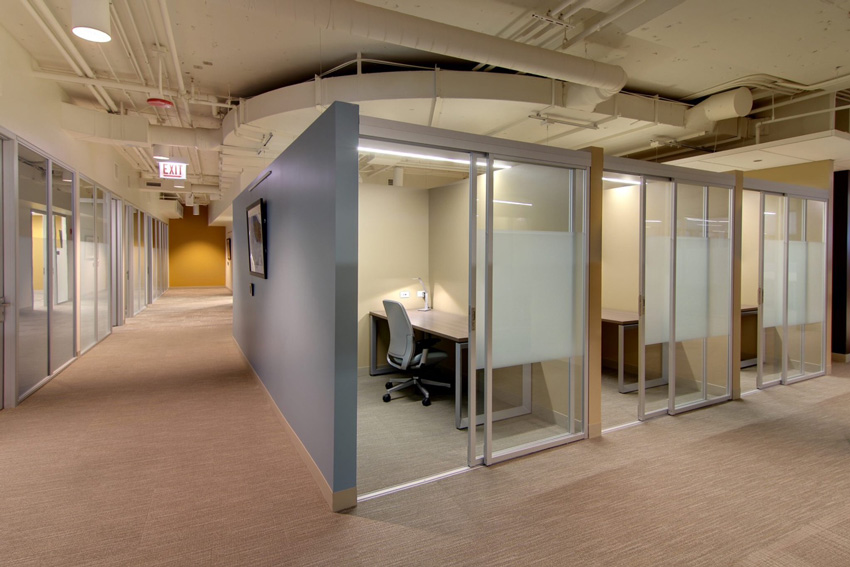Fantastically Flexible
Open Versus Closed Spaces
Another major role that interior glass partitions and stacking sliders play in commercial building designs is simultaneously supporting quiet, closed spaces and open, collaborative environments.
“Today’s knowledge workers perform a variety of work tasks on any given day, some requiring quiet, focused concentration, and others depending on interaction with others,” Murray relates. “Designing spaces to accommodate focused work that avoids the need to create permanently closed, traditional ‘office space’ can greatly improve space utilization and reduce costs.”
The fact is that today’s workforce, regardless of age, require a variety of spaces, providing them with the freedom to choose where, with whom, and how they work, whether individually or in collaboration with small or larger groups, Lubin says.
“Thoughtful and proximal blending of a variety of spaces for socializing, collaborating, focus, and rejuvenation is key to the office ecosystem of today,” he adds. “Specifically, ad hoc, reservable, open, and enclosed team spaces blend design, functionality, materiality, technology, furniture, and performance to achieve a successful/usable matrix of spaces for people to interact.”
Backing up these observations with hard data, Gensler’s 2016 U.S. Workplace Survey measured four elements of workplace design that foster innovation: individual focus work, collaboration, socializing—informal gathering that fosters trust and teamwork—and learning. According to the design firm’s research findings, choice of work settings contributes the most to employees feeling that their workplace fosters innovation.
Giving employees the ability to move freely around their work environment and work in different settings promotes creativity. Perhaps this is why government workers reported the lowest levels of choice in Gensler’s survey as they are largely tethered to their assignment seats.
“That lack of choice ends up interfering with both focus and collaborative work, and cuts down the sense of empowerment that motivates workers,” reports Robert A. Peck, government practice area leader, principal, Gensler, Washington, D.C., in a recent Gensler blog post, “Unlocking Innovation in the Government Workplace”. “The most innovative environments are those that foster both creative group work and creative individual thinking and provide spaces for both.”
Peck observes that legacy government workplaces tend to be unidimensional—either predominantly closed offices with meeting rooms or predominantly open work areas with few focus rooms and inadequate meeting room space. “In those legacy spaces, we rarely see a good mix of spaces or the café/pantry areas that double as informal meeting spaces and are often a hallmark of creative offices.”
While several systems and products would typically be required to create that desired, and arguably required, mix of open and closed environments, what’s unique about interior glass partitions is the fact that they can simultaneously support these two conflicting needs for enclosed privacy and open transparency, and personal choice.
Utilized as private offices or small conference areas, employees are afforded the quiet, private environment they need. At the same time, the all-glass walls help retain the openness and collaborative feeling that most office settings are seeking today.
Incorporating glass partitions in many of their coworking facilities, Serendipity Labs CEO John Arenas says that providing people with a variety of work settings based upon the activity they’re engaged in directly impacts creativity and innovation.

Interior glass enclosures help Serendipity Labs’ coworking facilities provide a balance of open collaborative work areas and offices that close and lock when needed. Small “phone booths” are used to maintain visual privacy while still bringing light into the space.
“We believe the trend going forward is having the right mix of spaces and opportunities to work in the ways you need to work,” states Arenas in a “Future of Workplace Trends for Startups” video. “That enables serendipities interactions that might otherwise not have happened and brings on creativity and new ideas.”
“It is critically important to provide an appropriate mix of these open and closed environments,” agrees LPA’s Thomas, “and the ratio varies for each end user based upon their business, work process, and culture.”
Supporting a high level of flexibility in accommodating the occasional all-hands meetings and group gatherings, Thomas is a big fan of stacking room dividers for breakrooms or large meeting rooms.
That said, it’s important to evaluate the acoustical integrity of the stacking room dividers when they are in the closed position, as breakrooms can be very noisy and easily transfer sound to adjacent office spaces. Furthermore, large meeting rooms require acoustical privacy and the ability to minimize confidential voice transfer to adjacent spaces.
To accommodate both individual and teamworking requirements, SERA Architects employs adaptability at multiple scales to support dynamic, changing needs. Along these lines, Blair recommends:
- Diverse space types distributed across the building, allowing for individual choice of work environments (e.g., quiet and busy spaces for both single occupants and team)
- Individual control of spaces for tuning environments to unique needs (for example, shades, lighting, mechanical systems, etc.)
- Flexible or modular systems—such as movable walls, acoustic panels, or furniture—that can be changed over periods of time, either by users or by facilities teams









